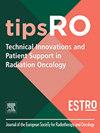Integrating Electronic Patient-Reported Outcome Measures (ePROMs) into Personalised Follow-up for Patients after Radiotherapy. A Feasibility Study
IF 2.8
Q1 Nursing
Technical Innovations and Patient Support in Radiation Oncology
Pub Date : 2025-08-07
DOI:10.1016/j.tipsro.2025.100333
引用次数: 0
Abstract
Background
There is an unmet need in patient monitoring between the end of radiotherapy and the first follow-up appointment during which patients may experience severe side effects. Personalised follow-up has the potential to tailor healthcare to individual needs. ePROMs enable remote monitoring and identification of those needing earlier intervention.
Purpose
To assess the feasibility of integrating ePROMs into personalised follow-up of patients after radiotherapy.
Materials and Methods
Patients with lung or head and neck (HN) cancer were enrolled. ePROMs questionnaires, comprising EQ-5D-5L and 14 lung or 19 HN cancer-specific questions adapted from CTCAE v5.0, were sent to patients at eight timepoints: pre-radiotherapy, mid-radiotherapy, end of radiotherapy, weekly for four weeks post-treatment, and first face-to-face follow-up appointment. Upon completion, automated advice was provided based on responses. Grade 2 or above symptoms were escalated to clinicians. Patient feedback was obtained through structured interviews.
Results
Over two months, 19 eligible patients (10 lung, 9 HN) were recruited: 13 received concurrent chemoradiotherapy, and six received radiotherapy alone. ePROMs completion rate was 69.1%, ranging from 47.4% to 89.5% at each timepoint. Three patients reported grade 3 or above symptoms on 5 instances during and after radiotherapy. Fourteen patients participated in the interviews: all 14 reported ePROMs were easy to complete, took an acceptable amount of time, and made them feel better supported.
Conclusion
Integrating ePROMs into personalised follow-up is feasible and acceptable to patients. ePROMs provide insights into patients’ symptoms during and after radiotherapy, highlighting the need for a tailored approach.
将电子患者报告结果测量(ePROMs)整合到放疗后患者的个性化随访中。可行性研究
背景:在放疗结束和第一次随访预约之间的患者监测需求尚未得到满足,在此期间患者可能会出现严重的副作用。个性化随访有可能根据个人需求量身定制医疗保健。eprom可以远程监测和识别那些需要早期干预的人。目的探讨将eprom纳入放疗后患者个体化随访的可行性。材料与方法纳入肺癌或头颈部(HN)癌患者。ePROMs问卷,包括EQ-5D-5L和14个肺癌或19个肺癌特异性问题,改编自CTCAE v5.0,在放疗前、放疗中、放疗结束、治疗后4周每周、第一次面对面随访预约等8个时间点发送给患者。完成后,根据响应提供自动建议。2级或以上症状升级到临床医生。通过结构化访谈获得患者反馈。结果在2个月的时间里,共招募了19例符合条件的患者(10例肺,9例HN): 13例同时接受放化疗,6例单独接受放疗。eprom完成率为69.1%,每个时间点的完成率从47.4%到89.5%不等。3例患者放疗期间及放疗后5例出现3级及以上症状。14名患者参加了访谈:所有14名患者报告eprom易于完成,花费可接受的时间,并使他们感到更好的支持。结论将eprom纳入个性化随访是可行且可接受的。eprom提供了放疗期间和放疗后患者症状的见解,强调了量身定制方法的必要性。
本文章由计算机程序翻译,如有差异,请以英文原文为准。
求助全文
约1分钟内获得全文
求助全文
来源期刊

Technical Innovations and Patient Support in Radiation Oncology
Nursing-Oncology (nursing)
CiteScore
4.10
自引率
0.00%
发文量
48
审稿时长
67 days
 求助内容:
求助内容: 应助结果提醒方式:
应助结果提醒方式:


